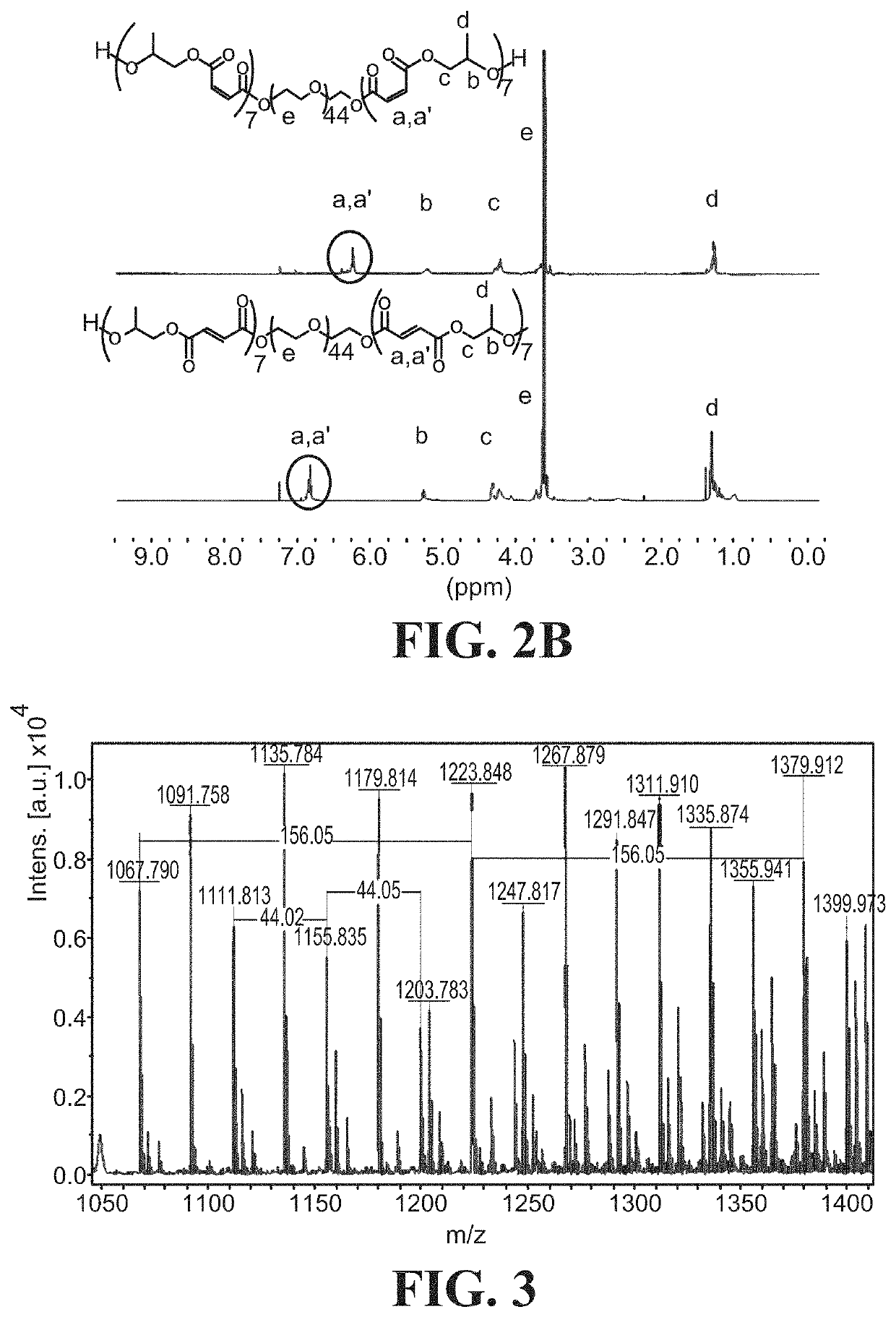Synthesis and characterization of well defined poly(propylene fumarate) and poly (ethylene glycol) block copolymers
a technology of polyethylene glycol and block copolymer, which is applied in the field of block copolymer of poly (ethylene glycol) and poly (propylene fumarate) (ppf), can solve the problems of limited hydrogel materials available for both techniques, limiting the variety and resolution control of scaffold architectures that can be produced, and not being used in applications that require hydration. , to achieve the effect of increasing the elongation at break
- Summary
- Abstract
- Description
- Claims
- Application Information
AI Technical Summary
Benefits of technology
Problems solved by technology
Method used
Image
Examples
example 1
Synthesis of Mg(BHT)2(THF)2 Catalyst
[0109]In a nitrogen filled, oven dried anti-bump Schlenk flask 13.22 g (0.06 mol) of 2,6-di-tert-butyl-4-methylphenol (BHT) was dried on high vacuum for 40 min. The flask was backfilled with nitrogen followed by the injection of 20 mL of anhydrous THF (0.31 mol). Once the BHT was dissolved, 30 mL of di-butyl magnesium 1.0 M in heptanes (0.03 mol) was added dropwise over the course of 1 h with the flask cooled on ice. The reaction was allowed to stir on ice for an additional 2 h before a white precipitate formed. The solvent was removed by vacuum transfer and the catalyst was dried overnight before storage in a glovebox. (17.5 g, 96% yield)
example 2
Drying Poly(Ethylene Glycol) Starting Materials
[0110]Poly(ethylene glycol) diol and methyl ether poly(ethylene glycol) starting materials were purchased from Sigma (2 kDa and 4 kDa PEG-diol and methyl ether PEG) and TCI (1 kDa PEG-diol and methyl ether PEG) dried according to previous literature. (See, Kinard, L.; Kasper, K.; Mikos, A. Drying Poly(Ethylene Glycol). Protoc. Exch. 2012, the disclosure of which is incorporated herein by reference in its entirety.) In brief, 10.00 g of each PEG derivative was dissolved in anhydrous toluene and refluxed overnight with a Dean-Stark apparatus. The solution was then cannula transferred to a dry round bottom flask with 3 Å molecular sieves overnight, then transferred to another dry round bottom flask with vacuum dried molecular sieves overnight. The toluene was then removed under vacuum and the PEG was transferred into a glovebox. For scale-up polymerizations the sieve drying steps were omitted as the reaction was found to be sufficiently dr...
example 3
Synthesis of Poly(Ethylene Glycol-b-Propylene Maleate) Using Methyl Ether PEG (MW 750), DP 20
[0111]Poly(ethylene glycol-b-propylene maleate) was synthesized by the copolymerization of maleic anhydride and propylene oxide to 20 degrees of polymerization (DP) initiated by methyl ether PEG (MW 750) and catalyzed by Mg(BHT)2(THF)2. as shown in Scheme 3, below.
Using standard Schlenk line techniques, an ampoule was filled with Mg(BHT)2(THF)2 (57.8 mg, 0.095 mmol), methyl ether poly(ethylene glycol) MW 750 (0.3573 g, 0.4764 mmol), propylene oxide (0.683 mL, 9.76 mmol) and maleic anhydride (0.9571 g, 9.76 mmol). The solution was dissolved into toluene to a total monomer concentration of 2 M. The ampoule was sealed and heated at 100° C. for 72 hours. The resultant polymer was recovered by precipitation in excess diethyl ether and characterized by 1H NMR ((300 MHz, 303 K, CDCl3): δ=6.28-6.24 (t, OC(═O)CH═CHC(═O)O), 5.30-5.20 (m, CH2CH(CH3)O), 4.29-4.22 (m, CH2CH(CH3)O), 3.64 (m, OCH2CH2O), 3....
PUM
| Property | Measurement | Unit |
|---|---|---|
| Temperature | aaaaa | aaaaa |
| Temperature | aaaaa | aaaaa |
| Fraction | aaaaa | aaaaa |
Abstract
Description
Claims
Application Information
 Login to View More
Login to View More - R&D
- Intellectual Property
- Life Sciences
- Materials
- Tech Scout
- Unparalleled Data Quality
- Higher Quality Content
- 60% Fewer Hallucinations
Browse by: Latest US Patents, China's latest patents, Technical Efficacy Thesaurus, Application Domain, Technology Topic, Popular Technical Reports.
© 2025 PatSnap. All rights reserved.Legal|Privacy policy|Modern Slavery Act Transparency Statement|Sitemap|About US| Contact US: help@patsnap.com



